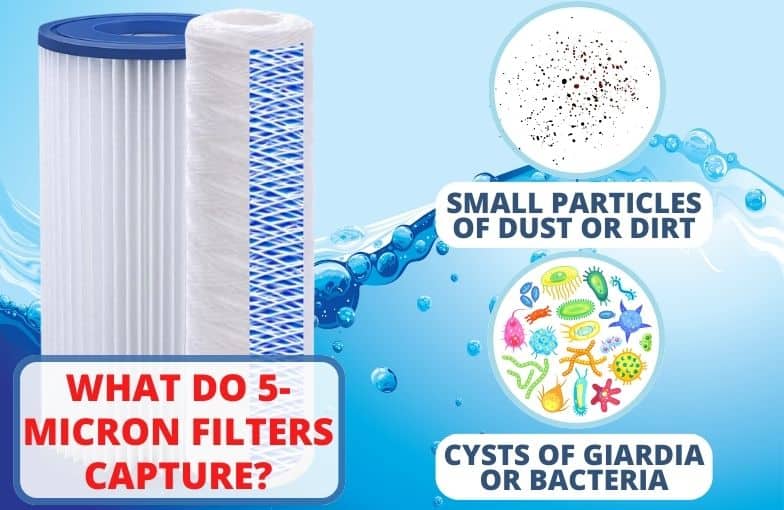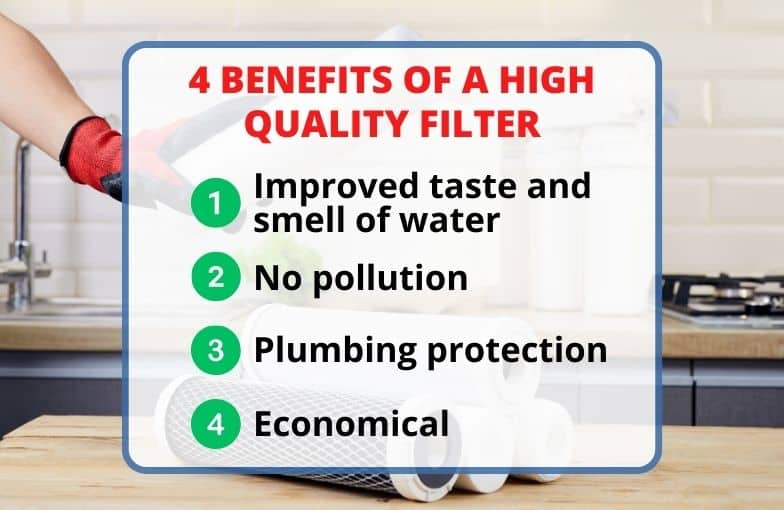Last Updated: November 16, 2023
What a micron water filter size is and what are its advantages? If you are looking for an answer to this query, you are at the right blog post. I have been in the field of filtration systems for more than a decade, helping customers to make the right decision. In this article, I’ll explain what is micron ratings and provide a detailed guide on the 4 sizes of these water filters. Let’s have a look!
Table of Contents
Quick Answer
I have played with plenty of filters and equipment for 10 years and found out they have the following benefits:
- Remove harmful particles;
- Remove dust and organic contaminants;
- Prevent diseases and scaling;
- Improve the water quality.
However, to get the above perks, buying the right filter is necessary. Continue reading below, where I’ll break down the complete concepts behind the filter. I’ll also discuss the 2 common filter types such as nominal and absolute filters. Moreover, a detailed discussion will be on 4 sizes available – 10, 5, 1, and 0.5 microns. Lastly, I will also touch on important considerations for maintaining your filter to ensure it provides clean and safe drinking water over time. Let’s have a look!
Read Also: Well Water Sediment Filter: The Ideal Water Filter Solution – Water Treatment
Water Filter Micron Rating: Understanding How Micron Size Affects to Water Filtration
While buying a filter, you may have noticed that it has micron sizes mentioned on them. For instance, I have a Sawyer squeeze filter, which is 0.1 absolute microns in size.
But what is this micron size, and how does it describe the efficiency of a water filter? Let’s break it down.
An Insight into the Micron
A micron is a unit of measurement equal to one-millionth of a meter. It describes the physical diameter of the pores in a filter that enables water to flow through while capturing contaminants. The lower the water filter’s micron rating, the smaller the particles it can effectively trap and remove.

As a point of comparison, the human eye can detect objects as small as 40 microns in size – approximately the thickness of a human hair strand. This provides some perspective on just how tiny a single micron is. The micron measurement allows you to understand the filtering capability of different water filters.
Overview of Micron Filter
The microfilter is made up of a thin membrane. This mesh-like membrane has tiny openings, measured in units called microns or micrometers.
Most home filters have a size of 0.5 microns to 20 microns. This indicates these filters can remove particles from 20 to 0.5 micro-millimeters in width. Some advanced filters can even eliminate contaminants as small as 0.1 to 0.0001 microns.

You can get help from a water test to detect contaminants in your supply. If you have larger sediment particles, a filter with a larger micron size, like 75-100, may work. But if you need to remove tinier particles, you may need a filter with a smaller micron measurement, like 1 micron.
Keep in mind that smaller micron rating filters may struggle with the flow and require more frequent replacement. It’s important to choose the filter size that balances the level of impurity removal needed with the flow rate desired.
To get a better understanding, I would recommend you check out this interesting video.
Exploring the Varieties of Micron Filters
Regarding micron filter classifications, there are a plethora of options exist on the market. However, I’ll categorize and discuss them into 2 main types:
Nominal Micron-Rated Filter
These filters have the following qualities:
- They eliminate most but not all particles within their specified range. For example, a 1-micron approximate filter blocks most 1-micron contaminants, but some could still pass through it.
- Nominal micron rating filters tend to remove 60-98% of particles in their range.
- Economic filters often use nominal micron filters and have an approximate rating for basic filtration and odor reduction. Carbon filters in the 0.5-50 micron range are examples of micron filters.

Absolute Micron-Rated Filter
Listed below are the important aspects you should know about these filters:
- They filter out 100% of particles larger than their rated size. Therefore, a 0.5-micron filter blocks everything 0.5 microns and up.
- Absolute micron ratings provide superior filtration but cost more. These are utilized for advanced sterilization or pharmaceuticals requiring definite micron ratings.
- Examples of absolute micron filters are stainless steel filters rated at 1 micron definite and ceramic filters rated at 0.2 microns definite.

What are Common Micron Size Options for Water Filters?
Now let’s take a closer look at some of the typical micron size options you’ll see with water filters and what they filter out:
10 Microns
The following are some characteristics of these filters:
- They usually trap visible particles like sediment, silt, or dirt.
- These are good for pre-filtration and particle screening.
- Despite being smaller, 10-micro filters can’t remove germs like bacteria or viruses.
- This type is mainly used in the oil or plant industry to remove larger particles.

5 Microns
The following are the main takeaways of 5-micron filters:
- A 5-micron rating is more efficient than a 10-micron and mostly filters small dust or dirt particles.
- These reduce cloudiness and particles that may affect taste or odor.
- This type can remove pathogens like Giardia cysts or bacteria like E. coli but is ineffective against tiny organisms.
- They are mostly used in the food or beverage industry, where quick filtration is required without affecting the overall performance.

1 Micron
1-micron filter type comes with the following properties:
- They can remove most bacteria and smaller viruses like the Hepatitis A virus.
- These filters are mostly employed in filtration systems and have fast flow rates.
- Industries like food get benefitted from this type, where moderate to deep filtration is required.


0.5 Microns
This type has the following functions:
- These are usually used after pre-filters or as secondary filters to enhance the filtration process.
- They reduce health risks from common bacteria
- 0.5-micron type can even filter the ultrafine particles, including viruses and most bacteria.

Here is the thing – apart from the above 4 types, there is a range of micron sizes of filters that are used in water filters. The table below quickly differentiates some notable sizes and particles they remove. Let’s have a look:
Micron Size (micrometer) | Particle They Remove |
0.0001 – 0.0009 | Oxygen, sugars |
0.001 – 0.009 | Atmospheric dust, viruses |
0.01 – 0.09 | Combustion or smoke particles, coal fuel gas |
0.1 – 0.9 | Corn starch, face powder, asbestos, bacteria, bromine |
1 – 9 | Anthrax, antiperspirant, bone dust, burning wood, zinc calcium/carbon black dust |
10 – 99 | Fertilizers, asbestos, dust, Cayenne pepper, coffee, mold, textile fiber |
100 – 999 > | Sand, ash, fibers |
Now that we have gone through the table let’s head on to the next section and learn about the positives and negatives of the filters.
Read Also: Do Brita Filters Remove Microplastics from Water? – Water Treatment
What are the Perks of Using a High-Quality Water Filter?
The following are the plus points of using a high-quality water filter system.

1. Making Your Water Taste and Smell Better
An effective filter will remove chlorine and particulate matter that causes unpleasant tastes and odors. This will make your water fresher and give it a cleaner taste.
I remember once my whole family suffered from Diarrhea due to drinking from a low-grade filter while hiking at Zion National Park. Center for Disease Control (CDC) also mentions some more disease-causing agents that could be caused due to bad filtered water, including:
- Arsenic;
- Lead;
- Copper;
- Campylobacter;
- Enterovirus;
- Rotavirus;
- Shigella.
2. Removing Harmful Contaminants
The right filter protects you from dangerous microscopic contaminants like bacteria, viruses, cysts, or lead. It can also remove a range of other chemicals, like asbestos, that can cause dangerous lung cancer.
3. Longer Life for Plumbing and Appliances
A quality water filter reduces scale buildup from hard water minerals. This helps prevent costly damage to plumbing pipes, fixtures, and water-using appliances.
4. A Cost-Effective and Eco-Friendly Option
Bottled water creates plastic waste and is expensive over time. A filter provides the same quality water as bottled but is freshly filtered from your tap. This eliminates plastic bottle waste and saves money in the long run compared to purchasing bottled water.
Shedding Light on the Downside of Low-Micron Filters?
While we’ve focused on the benefits of high-quality, low-micron filters, they aren’t perfect solutions. There are some potential drawbacks to consider as well. Let’s have a look:
1. Flow Loss and Reduced Water Pressure
The tighter pores make it harder for water to pass through. This may result in weaker pressure from your taps and showers. If the flow rate is your priority, you’ll want to avoid the tightest filters under 1 micron.
2. Higher Upfront and Maintenance Costs
Low-micron filters often require higher-quality materials and construction to achieve such fine filtration. This means the filters themselves can be more expensive than filters with larger micron sizes.
Moreover, ongoing maintenance is also higher since the tight pores get clogged faster by trapped particles and require frequent filter cartridge changes.
Why Micron Ratings are Vital for Whole-House Filtration?
We are heading to the finale of our discussion, and many of you must be thinking: what’s even the point of water filter micron ratings in whole-house filtration? I have comprehensively answered the question below:
- Filters all water entering the home: With whole-home filtration, every drop of water is filtered before reaching faucets and appliances. So, the micron rating affects your entire water supply.
- Removes contaminants from many sources: Whole-home systems filter out pollutants from municipal supplies, well water, and old pipe corrosion. An adequate micron size is needed to catch various particles.
- Provides presence-wide protection: Lower micron ratings ensure all family members are protected from bacteria and other organisms.
- Maximizes equipment longevity: Tiny contaminants shorten the life of appliances like water heaters. Tighter microns remove more of these particles for longer equipment life.
Choosing the Right Micron Rating: How Many Microns Should Your Water Filter Be?
To make sure you choose the most effective filter for your needs, it’s worth considering the specific impurities you want to eliminate, even if you anticipate that this may require a more specialized or expensive option. The micron filter efficiency is directly related to the size of the particles that the filter can catch. A smaller micron rating means that the filter can capture smaller particles, but it also means that the filter may clog more quickly and require more frequent replacement.

Listed below are the 4 crucial considerations for choosing the right micron rating for your filter:
- Water source: Your water source can impact the type of filter you need. For example, if your water comes from a well, you may need a filter with a lower micron rating to remove sediment and other impurities. On the other hand, if your water comes from a municipal supply, a filter with a higher micron rating may be sufficient. A water filter with a micron range of 75-100 microns is good enough to remove sediments from a well or water supply.
- Impurities: Consider the specific impurities you want to remove from your water. For example, you’ll need a filter with a micron rating of 1 or less if you want to remove bacteria and viruses. However, a filter with a higher micron rating may be sufficient if you’re primarily concerned with removing sediment and larger particles.
- Flow rate: A filter with a smaller micron rating may impact the flow rate of your water. If you have a high flow rate requirement, you may need to choose a filter with a larger micron rating.
- Maintenance: Filters with smaller micron ratings may require more frequent maintenance and replacement. Consider the cost and effort required to maintain your filter when choosing the right micron rating for your needs.
Considerations for Filter Maintenance
If you have installed a water filter in your home, it is important that you properly take care of it. Follow these points to maintain your water filter carefully:
- Inspection: Routinely inspect and replace any damaged parts to guarantee optimal performance and longevity. Filters with smaller micron ratings may need more frequent replacements due to tinier pores and increased clogging risk.
- Follow Replacement Time: Follow the manufacturer’s recommended replacement timeline. Also, factor in your water’s impurity levels when deciding how often to swap filters.
- Maintenance: Beyond regular replacement, properly clean and maintain the filter to maximize lifespan and efficiency. Regularly flushing out trapped sediment and debris, cleaning the filter housing, and storing the filter correctly when not in use to prevent damage or contamination.
How Pressure Drop Impacts Micron Filter Performance?
A critical factor in micron filter effectiveness is pressure drop. This refers to the reduction in water pressure between the inlet flow and outlet flow of the filter. Some pressure is lost as water passes through the porous filter media to trap contaminants.
Over time, this pressure drop increases as more particulates get trapped in the filter. The rising pressure drop makes it harder for water to pass through the filter. This reduces the flow rate from your faucets and showers. Once the pressure drop exceeds the recommended levels for the filter, it needs to be changed.
FAQs
What are some common materials used in water filters, and how do they affect micron ratings?
Did you know that filtering materials like activated carbon or ceramic can affect micron rating variability? Activated carbon has a nominal rating of 20 microns, while ceramic can go as low as 0.2 microns.
Can a water filter with a higher micron rating still effectively remove harmful contaminants?
A water filter with a higher micron rating may still remove some harmful contaminants, but effectiveness tradeoffs exist. Micron rating variability means that different filters are needed for specific impurities and levels of removal.
Are there any downsides to using a water filter with a very small micron rating?
Remember, “too much of anything is a bad thing.” While a smaller micron rating offers advantages such as removing bacteria and viruses, limitations include a decrease in flow and frequent replacement.
How do you properly dispose of used water filter cartridges?
Proper disposal of used filter cartridges is crucial to minimize their environmental impact. Check with local recycling facilities for drop-off options, or send them back to the manufacturer for proper disposal.
Can different types of water sources, such as well water or municipal water, require different micron ratings for effective filtration?
Different water sources have varying levels of impurities, requiring different micron ratings for effective filtration. Water quality and filtration technology are crucial factors to consider when selecting a filter.
What is a micron in a water filter?
A micron is a size measurement, with one micron equaling one-millionth of a meter. The micron rating refers to the physical size of pores in a filter.
What is the best micron level for a water filter?
For a filter used for drinking water, 0.5 to 1 micron is typically recommended as the best micron level to remove most bacteria and protozoan cysts.
How many microns should a water filter be?
Most water filters range from 5 to 0.5 microns, with 0.5 to 1 microns ideal for drinking water and removing common microscopic contaminants.
Is 50 microns good for a water filter?
50 microns is more appropriate for pre-filtration or sediment screening than primary drinking water filtration. Smaller microns of 1 or less better protect from bacteria.
How many microns is safe in drinking water?
For safe drinking water, the micron level should be 3 or lower to remove dust and microorganisms. 0.5 – 2 micron size is recommended to get clean drinkable water.
What is the water filter micron rating?
A water filter micron rating is the measurement of the size of a particle that it can remove. For example, a water filter with 0.5 micron ratings can remove any particle with a size of 0.5 microns or larger.
Conclusion
Congratulations! You’ve now gained a thorough understanding of water filter micron ratings. By now, you know that micron size refers to the size of particles that a filter can trap and that different filters have varying ratings to tackle different impurities.
You also understand the importance of choosing the right micron rating and ensuring proper filter maintenance. Now that you have this knowledge, you can confidently choose the right water filter for your specific needs.
Remember to consider factors such as the source of your water, the type and level of contaminants present, and your budget. By selecting a filter with the appropriate micron rating and maintaining it regularly, you can ensure that your drinking water is clean, safe, and free of harmful impurities.
In conclusion, whether you’re a residential, commercial, or industrial client, the importance of water filter micron rating cannot be overstated. By taking the time to understand micron size, choosing the right micron rating, and properly maintaining your filter, you can safeguard the health and well-being of yourself and those around you.
Recommended read:
NSF Certified Water Filters: Why It’s Important – Water Treatment

